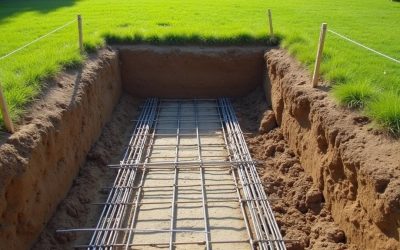Are you looking for ways to make your metal garage more comfortable and energy efficient? Wondering what is the best way to insulate a metal garage?
The best way to insulate a metal garage is to use insulation materials such as fiberglass batts, spray foam or rigid foam boards. The insulation material should be fitted between the metal framing or walls of the garage. An important thing to consider is to use an insulation material with a high R-value to ensure maximum insulation.
Insulating your metal garage is an effective way to reduce heating and cooling costs, protect your belongings from extreme temperatures, and provide a more comfortable living space.
When people usually make metal garages, they assemble them without insulation. However, insulation can be very important, even though it isn’t required. This is even more so in areas prone to certain environmental conditions. Good insulation can protect the belongings that are stored inside and also provide comfort. One of the important reasons to insulate your metal garage is to prevent moisture.
In this article, we’ll discuss the benefits of metal garage insulation, the different types of insulation available for metal garages, how to prevent air leaks in your metal garage, and tips for enhancing thermal performance. With these helpful tips, you can make sure that your metal garage is properly insulated so it can withstand any weather condition!
What is Metal Garage Insulation?
Metal garage insulation is a great way to improve the comfort, energy efficiency, and durability of your metal garage.
By adding insulation to your metal structure, you can reduce heat loss in the winter and keep out the heat in the summer.
Additionally, insulation will help prevent condensation from forming on cold water pipes, which can lead to visible signs of damage or destruction.
There are several types of insulation available for metal garages that vary in both cost and performance levels.Even though insulation protects from condensation it can make your metal building flammable. To prevent this, it’s good to know what type of insulations there are and how to insulate your metal garage using a particular type.
Spray Foam Insulation
Spray foam is very convenient for odd spaces because it can easily be sprayed to fit any cavity. While it expands, it starts to harden and becomes a solid plastic with air cells. Spray foam insulation is very hard to remove once it’s dry, so be careful to avoid any spills.
You should know that this type of insulation for metal building is a better air barrier than batt insulation. However, spray foam insulation is more expensive than batt insulation, so you should keep this in mind as well.
Batt and Blanket Insulation
As mentioned above, batt insulation is not an expensive choice, however, it should be properly installed to be fully effective. Blanket insulation is rolled insulation cut to exact measurements of your garage.
This type of insulation offers an easy to install, cost effective solution that can help keep your building comfortable all year long.
Blanket/Batts insulation comes in a variety of sizes and thicknesses, making it simple to find the perfect fit for any space or structure.
This type of insulation also provides excellent soundproofing properties and helps reduce heat transfer. Additionally, batts are highly energy efficient and are often made from recycled materials such as cotton, wool, denim and fiberglass – making them an eco-friendly choice for your metal garage needs!
For best results, make sure to properly install your blanket/batts insulation to ensure it performs correctly.
Fiberglass Insulation
Fiberglass insulation is a common and affordable option for insulating metal buildings, but its soft batting texture may not be the safest choice. It can absorb moisture or attract birds, bugs, or rodents.
So, this type of insulation may not be the best choice for insulating metal buildings, as you don’t want mold in your garage.
Rigid Board Insulation
Rigid board insulation is flexible for any type of building. It’s a good choice for putting out moisture, heat, and noise. It is composed of fiberglass, polystyrene, or polyurethane.
Rigid board insulation is a popular choice for metal garages and other steel structures due to its incredible thermal performance.It can help create an airtight seal and prevent air leaks, allowing your structure to stay comfortable all year long. Additionally, it can also block UV rays and stop radiant heat transfer.
Along with providing great thermal protection, rigid board insulation can also help reduce noise levels and prevent the transfer of heat between different objects in tight spaces such as cold water pipes.
Since this type of insulation has superior performance compared to other materials, it’s no wonder why it’s the most popular choice for metal buildings.
If you decide to choose this type of insulation, talk to your supplier so they can adjust it to your metal building. Make sure you properly install your rigid board insulation to ensure optimal performance and avoid visible condensation on metal studs or other surfaces within your structure.
Insulated Metal Panels
Insulated panels have a higher cost compared to other insulation options, but offer quick installation and superior insulation. Insulated metal panels are constructed with a foam core sandwiched between two metal panels, resulting in a cleaner and more aesthetically pleasing appearance compared to other insulation options.
The 3-in-1 panel combines the installation of your outside metal panel, insulation, and inside liner panel into one simple process.
Reflective Foil Insulation
Reflective foil insulation is a more expensive option compared to other types of insulation, but it offers simple installation using basic tools such as nails, glue, and staples. Furthermore, it is a clean option.
Because reflective foil insulation is waterproof, it can give a lighter look to the inside of your metal garage.
Loose Fill Insulation
This type of insulation can fit into every corner, but it might cost you more than using a different type of insulation. Loose fill insulation consists of pellets or loose fiber.
Double Bubble Foil-Faced Bubble Wrap
Double bubble consists of two layers of reflective aluminum foil and air bubbles sandwiched between them, creating a strong barrier against heat transfer.
In addition to providing excellent thermal protection, double bubble foil-faced bubble wrap insulation can also reduce noise levels and help prevent the transfer of heat between different objects in tight spaces such as cold water pipes.
This product is easy to install and requires no special tools or skills, making it ideal for do-it-yourselfers.
To get the most out of this insulation, make sure you use double-sided tape when installing it to ensure proper adhesion and avoid gaps in coverage that could lead to energy loss.
With proper installation and maintenance, double bubble foil-faced bubble wrap insulation can be a great option for your metal building project.
Radiant Barrier Sheets
Radiant barrier are made of lightweight aluminum and feature a reflective surface that helps to reduce heat gain and keep the interior of your structure cooler in the summer months.
In addition to reducing energy costs, radiant barrier sheets can also protect against mold growth, dust accumulation, and excessive condensation.
Installing these sheets is relatively easy and doesn’t require any special tools or skills. Simply measure the area you want to cover, cut the sheet according to your measurements, then attach it firmly with screws or tape.
It’s important to remember that radiant barrier sheets should be installed on the interior side of your steel building for optimal efficiency. With proper installation and maintenance, radiant barrier sheets can provide superior insulation in your metal garage.
Garage Door Insulation
Garage doors are typically the largest non-insulated surface in a home, so insulating them will make your garage feel more comfortable overall.
In winter, uninsulated garages can drop below freezing, while summer temperatures can soar. While a new insulated garage door will have the most significant impact, the cost is usually too much for most homeowners.
A quick win is to add garage door insulation to your existing door.
Garage door insulation kits can be added to new or existing garage doors. Usually made of foam or reflective barriers, these kits offer R-values between R-2 and R-8. Compare this to a new insulated garage door ranging from R-6 to R-19.
Insulating the garage door, combined with weatherstripping and insulating other garage areas, can increase indoor temperature by 10 to 12 degrees in winter.
Preventing Air Leaks in Your Metal Garage
When you’re looking for ways to insulate your garage, one of the first things you should do is check for air leaks. Air leaks can cause heat or cool air to escape, leading to higher energy costs and an uncomfortable environment.
Fortunately, there are a few simple steps you can take to help prevent air leaks in your metal garage. Start by sealing any gaps between doors and windows with weather stripping or caulk, then add insulation around pipes and ducts.
You should also inspect the walls for any visible cracks or holes, then fill them with spray foam insulation or an expanding foam sealant.
Finally, make sure that all vents are covered with mesh screens that will help keep out drafts and unwanted pests.
By sealing any air leaks in your metal garage, you can help create a more comfortable and energy-efficient environment. And, with the right caulk and expanding foam around doors and windows, you can further reduce energy loss from your garage.
Caulking and Expanding Foam Around Doors and Windows
Caulking and expanding foam are two of the most effective ways to insulate your metal garage and prevent air leaks.
Caulk is a great option for filling any small gaps or cracks around doors, windows, or vents. It’s easy to apply, waterproof, and helps keep out drafts while also providing an airtight seal.
For larger gaps or cracks, expanding foam is another great choice as it expands when applied to fill in the space and create a tight seal. It’s also highly durable and can help insulate against sound as well as heat transfer.
Both caulking and expanding foam are inexpensive solutions that will help make your metal garage more energy-efficient by reducing the amount of air that escapes from the structure. So if you’re looking for a simple way to increase your garage’s thermal performance, consider caulking and expanding foam!
Weather Stripping Around Doors and Windows
Weather stripping around doors and windows is an affordable and easy way to insulate your metal garage. It’s a great option for preventing drafts and air leaks, as it helps create a tight seal when applied around the frames of your door and window openings.
Weather stripping comes in a variety of materials, such as foam, rubber, or vinyl. The most popular choice is foam weatherstripping, as it’s lightweight, flexible, and provides superior insulation while also helping reduce noise levels inside the garage.
To install weatherstripping correctly around your metal garage doors and windows, you’ll need to measure the perimeter first to determine how much material you’ll need. Then use double-sided tape or nails to attach the weatherstripping directly onto the frames of your door or window.
Finally, test it out by opening and closing the door or window several times to make sure that the weatherstripping is providing an effective seal against drafts. With proper weather stripping in place, you can feel confident that your metal garage will be more energy-efficient in both winter and summer months!
Blocking Off Gaps Along the Roofline
Gaps along the roofline of your metal garage can allow heat to escape during colder months, reducing the thermal performance of your building.
Luckily, there are a few easy solutions for sealing up these gaps. A good starting point is to use spray foam insulation around any openings or penetrations on the roofline.
This type of insulation expands and fills in any cracks or gaps, providing an airtight seal that will help maintain your desired temperature inside the metal garage.
Another option is to install a radiant barrier on top of the existing roof decking. Radiant barriers are aluminum sheets that reflect heat away from your structure, helping reduce heat transfer and keeping temperatures more consistent throughout the year.
Lastly, you can use caulk or weather stripping around windows and doors to further improve insulation along your metal garage’s roofline. With these simple steps taken care of, you’re one step closer towards energy-efficient comfort!
Conclusion
If you are planning to build or renovate your metal garage, it is safe to say insulation is without a doubt a worthy investment.
To find the right system of insulation, you should contact professionals, so they can advise you which one is the best option for you.
In order to have a safe, dry, and protected garage, it is important to choose the right type of insulation for your metal garage.
- Can I Release Equity From My Rental Property? - August 22, 2025
- How Much Will a Plumber Charge to Replace a Radiator? - August 22, 2025
- Should I Replace 20 Year Old Radiators? - August 22, 2025


